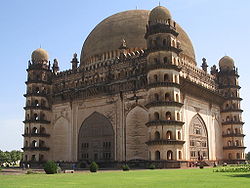Bijapur district, Karnataka
|
Vijayapura District ವಿಜಯಪುರ ಜಿಲ್ಲೆ Bijapur, Bijjanahalli |
|
|---|---|
| district | |

|
|
 Location in Karnataka |
|
| Coordinates: 16°49′N 75°43′E / 16.82°N 75.72°ECoordinates: 16°49′N 75°43′E / 16.82°N 75.72°E | |
| Country |
|
| Region | South India |
| Headquarters | Bijapur |
| Talukas | Bijapur, Basavan Bagewadi, Sindagi, Indi, Muddebihal |
| Area | |
| • Total | 10,541 km2 (4,070 sq mi) |
| Population (2010) | |
| • Total | 2,206,918 |
| • Density | 250/km2 (600/sq mi) |
| Languages | |
| • Official | Kannada |
| Time zone | IST (UTC+5:30) |
| Telephone code | + 91 (0) 8352 |
| ISO 3166 code | IN-KA |
| Vehicle registration |
|
| Website | bijapur |
Vijayapura district Previously known as Bijapur district is a district in the state of Karnataka in India. The city of Bijapur is the headquarters of the district, and is located 530 km northwest of Bengaluru. Bijapur is well known for the great monuments of historical importance built during the Adil Shahi dynasty.
While archaeological evidence indicates that the area was settled by the late Paleolithic, the legendary founding of the city of Bijapur was in the late 900s under Tailapa II, who had been the Rashtrakutan governor of Tardavadi, and after the destruction to the empire caused by the invasion of the Paramara of Malwa, declared his independence and went on to found the empire of the Chalukyas of Kalyani, where the city was referred as Vijayapura ("City of Victory"). By the late 13th century, the area had come under the influence of the Khilji Sultanate. In 1347, the area was conquered by the Bahmani Sultanate of Gulbarga. By this time the city was being referred as Vijapur or Bijapur.
In 1518, the Bahmani Sultanate split into five splinter states known as the Deccan sultanates, one of which was Bijapur, ruled by the kings of the Adil Shahi dynasty (1490–1686). The city of Bijapur owes much of its greatness to Yusuf Adil Shah, the founder of the independent Bijapur Sultanate. The rule of this dynasty ended in 1686, when Bijapur was conquered by the Mughal emperor Aurangzeb. In 1724 the Nizam of Hyderabad established his independence in the Deccan, and included Bijapur within his dominions. In 1760, the Nizam suffered a defeat by the Marathas, and ceded the region of Bijapur to the Maratha Peshwa. After the 1818 defeat of the Peshwa by the British in the Third Anglo-Maratha War, Bijapur passed into the hands of the British East India Company, and was assigned to the princely state of Satara.
...
Wikipedia
